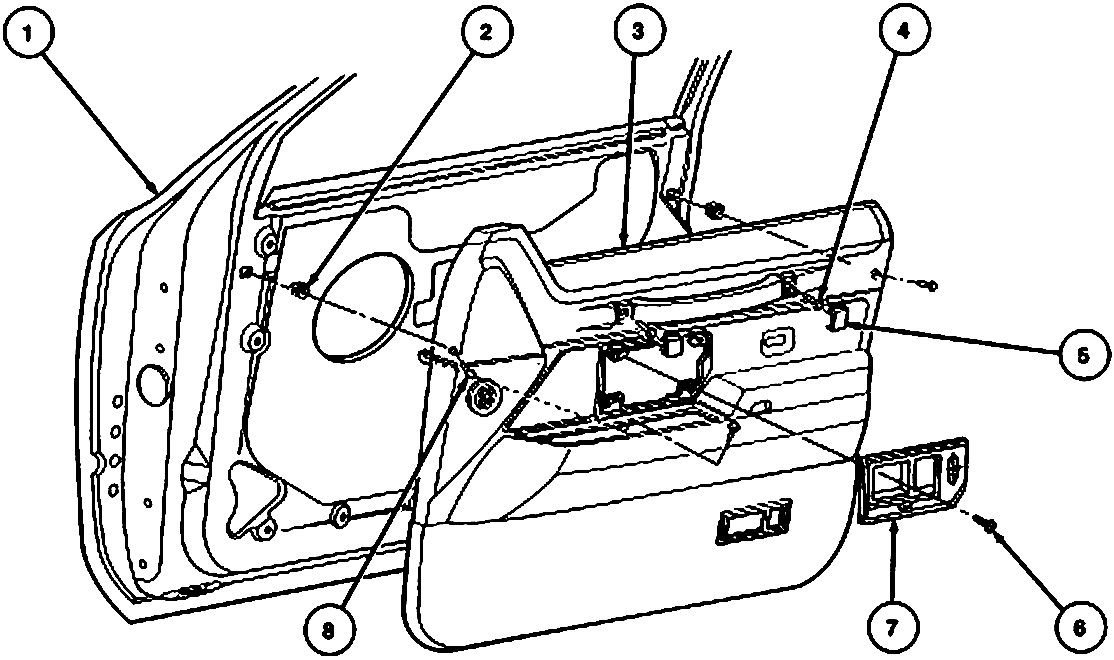Vehicle doors allow people to get inside the vehicle without having a permanent hole in the body. They usually have a handle (which can be pulled to open the door when unlocked) on both the outside and inside, and sometimes have a protective piece (usually made of plastic) which keeps the door from getting damaged from light collisions (such as from shopping carts).
Some vehicle body styles are determined by the number of doors a vehicle has, such as a coupé (two door) or sedan (four door). Sometimes the rear hatch on a hatchback is considered a door, which is where three door and five door body style names originate from.
The edge of a door typically takes the shape of the vehicle's body it comes close to, with enough gap between them for a seal to be made out of weatherstripping, with two layers on many modern vehicles.
Gullwing Doors
Gullwing doors are hinged at the roof, parallel with the car's direction, front to back. They were named after the shape that they form when open, which resembles a seagull's wings when fully extended. Gullwing doors move further out of the way of the path of the person getting in or out of the vehicle, but often require a mechanical assist for lifting the door up.
Many vehicles will be equipped with sensors to detect when each door is open, so that a door ajar light can illuminate and inform/warn the driver.
"Falcon" Doors
A variant on the gullwing design, "falcon" doors have another hinge point which allows them to open in much tighter spaces. The second hinge is just above the window, and only has to move a slight amount to keep the door from opening into anything off to the side of the vehicle. The video shows falcon-wing doors in use on a Tesla Model X crossover.
Scissor, "Lambo", or Lamborghini Doors
These doors are hinged at the same general location of normal doors, but open up vertically instead of outwards. These were made famous by Lamborghini, which is the origin of the slang term "Lambo Doors". However, not every Lamborghini has doors with this hinge design, and Lamborghini wasn't the only manufacturer to produce vehicles with this door design.
This modification is popular among enthusiasts that try to make their vehicle as far from stock as possible. Many other unusual door hinge designs are mistakenly called "Lambo doors" as well.
"Suicide" Doors
A normal door has a hinge towards the front of the vehicle, so that the back of the door swings open. "Suicide" doors have their hinges at the back, so that the front swings open. This and the modern standard were the two original types, going as far back as pre-motor vehicle times. "Suicide" doors are rarely produced any more, and are typically only found on old models and vehicles that have been modified.
Canopy Openings
Only called a door because it still creates the opening people can use to enter the vehicle, canopy "doors" are roofs that open up from a low enough point that traditional doors aren't required. This design is quite heavy, and is usually only found on concept cars and some one-seater race cars.
Dihedral/Butterfly
This door design is almost a mix of a gullwing and standard door, but requires a more complex hinge system to allow it to open diagonally. Due to the added cost of engineering a door like this into a particular vehicle, it is much less common, and usually only found on vehicles which are already expensive to begin with.
Dihedral Synchro-Helix
One of the most complex door hinge designs conceived, this door is similar to a scissor door but also moves away from the car as it rolls forward.
The first production vehicle with this design was the Koenigsegg Agera, a high performance car (seen in the video at the right) with a small cabin shape that made the use of this door design possible.
- Metal Shell
- Front Trim Interior Connection
- Door Trim Seal
- Handle Bolt/Screw
- Handle Bolt/Screw Cover
- Pull Handle Cup Screw
- Pull Handle Cup
- Screw/Bolt & Washer
List of Door Parts

Here are the names of all the parts that are numbered in the picture above:
Most doors will differ in some ways (especially those found on really old cars), but the main idea is commonly found on modern vehicles. The door trim is often one of the first things to be removed when reducing the weight of a vehicle for racing purposes.
